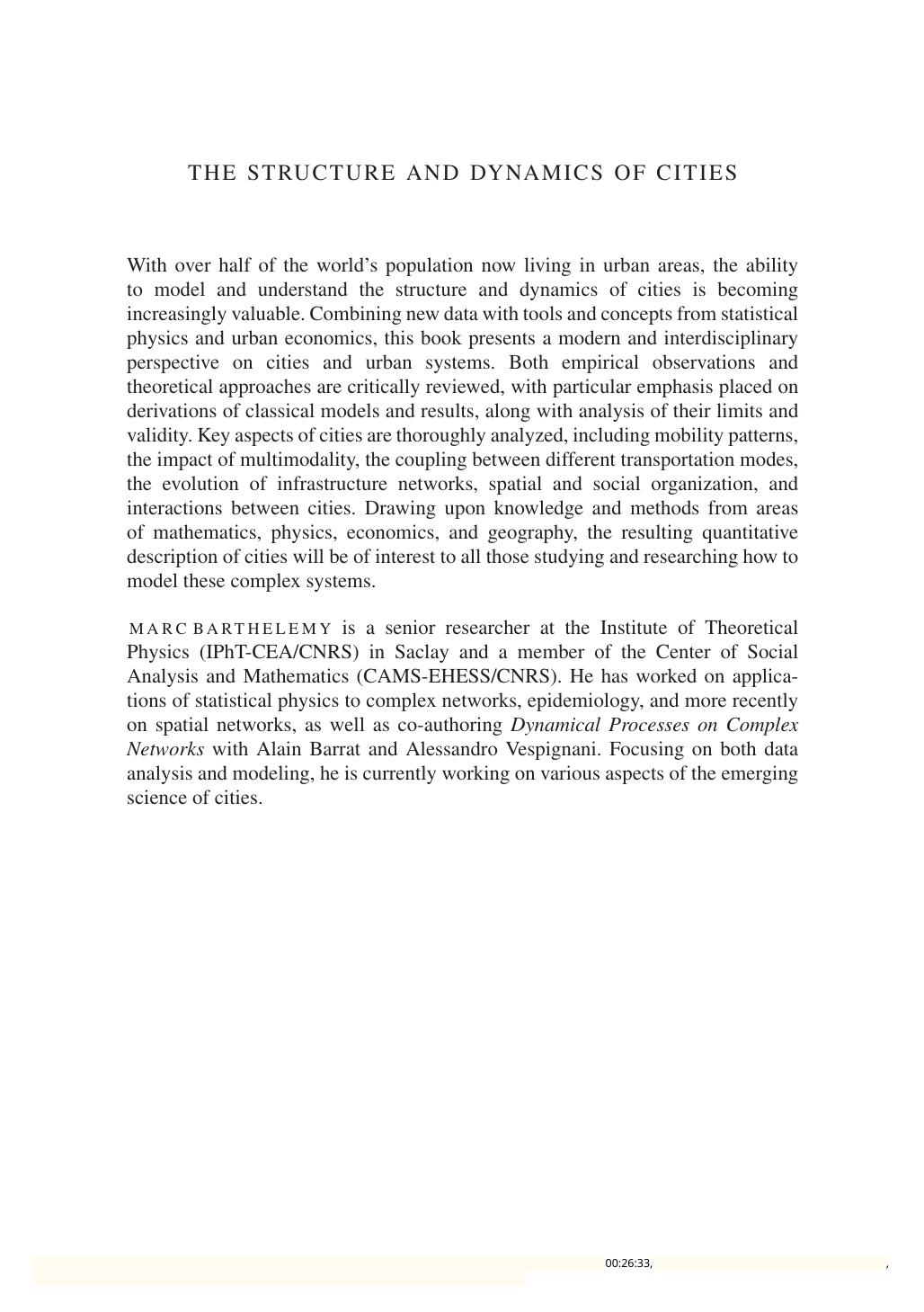The Structure and Dynamics of Cities 1st edition by Marc Barthelemy 9781316797532 1316797538
$70.00 Original price was: $70.00.$35.00Current price is: $35.00.
Instant download CUP The Structure and Dynamics of Cities 1107109175 after payment
The Structure and Dynamics of Cities 1st edition by Marc Barthelem – Ebook PDF Instant Download/Delivery: 9781316797532, 1316797538
Full dowload The Structure and Dynamics of Cities 1st edition after payment

Product details:
• ISBN 10:1316797538
• ISBN 13:9781316797532
• Author:Marc Barthelem
The Structure and Dynamics of Cities
Urban Data Analysis and Theoretical Modeling
With over half of the world’s population now living in urban areas, the ability to model and understand the structure and dynamics of cities is becoming increasingly valuable. Combining new data with tools and concepts from statistical physics and urban economics, this book presents a modern and interdisciplinary perspective on cities and urban systems. Both empirical observations and theoretical approaches are critically reviewed, with particular emphasis placed on derivations of classical models and results, along with analysis of their limits and validity. Key aspects of cities are thoroughly analyzed, including mobility patterns, the impact of multimodality, the coupling between different transportation modes, the evolution of infrastructure networks, spatial and social organisation, and interactions between cities. Drawing upon knowledge and methods from areas of mathematics, physics, economics and geography, the resulting quantitative description of cities will be of interest to all those studying and researching how to model these complex systems.
The Structure and Dynamics of Cities 1st Table of contents:
1 Urban systems
1.1 A science of cities
1.1.1 The nature of the problem
1.1.2 What is a city? Origins and definitions
1.2 Spatial and temporal scales
1.2.1 Population
1.2.2 Area, density, and volume of cities
1.2.3 Time scales
1.3 Naïve scaling
1.3.1 Surface area
1.3.2 Total length of roads
1.3.3 Total daily commuting distance
2 Models and methods
2.1 Statistical physics of complex systems
2.2 The shape of a science of cities
2.3 How many parameters?
2.3.1 Statistical physics and relevant parameters
2.3.2 Modeling cities
2.4 Critiques of urban economics
2.4.1 Interactions and equilibrium
2.4.2 Invariance with respect to utility choice
2.5 Data
2.5.1 Sources
2.5.2 Different types of data
2.5.3 Data are not enough: models
2.6 The barriers to interdisciplinarity
3 The spatial organization of cities
3.1 Optimal locations
3.1.1 Distribution of public facilities
3.1.2 Distribution of retail stores
3.2 Measuring a polycentric structure
3.2.1 Definition
3.2.2 Identifying and counting hotspots
3.3 Polycentricity: Classical approaches
3.3.1 The Fujita–Ogawa model
3.3.2 The edge-city model
3.4 Revisiting the Fujita–Ogawa model
3.4.1 A complex quantity described as random
3.4.2 Monocentric-polycentric transition
3.4.3 Number of centers
3.4.4 Consequences for mobility
3.4.5 CO2 emission and gasoline consumption
3.4.6 Urban villages
3.4.7 The most economical population distribution
4 Infrastructure networks
4.1 Roads and streets: patterns
4.1.1 Length of the network
4.1.2 Statistics of blocks
4.1.3 Structure of paths
4.2 Evolution of the road network
4.2.1 Basic properties
4.2.2 Simplicity profile
4.2.3 Betweenness centrality impact
4.2.4 Evolving patterns of betweenness centrality
4.2.5 Modeling the road network
4.3 Subways
4.3.1 All large cities have a subway system
4.3.2 Convergence to a universal structure
4.3.3 Scaling and modeling for subways
4.4 Digression: Railroads
4.4.1 Scaling
4.4.2 Are subways and railroads the same?
5 Mobility patterns
5.1 Typology of origin–destination matrices
5.1.1 Extracting coarse-grained information from OD matrices
5.1.2 Comparing mobility networks
5.2 Modeling mobility patterns
5.2.1 Statistics of flows: from gravity to radiation
5.2.2 Commuting and income
5.3 Human mobility: Levy flights or accelerated walkers?
5.3.1 Back to basics: empirical observations
5.3.2 Modeling the hierarchy of modes
6 Multimodality in cities
6.1 A multilayer network view of urban navigation
6.1.1 Empirical observations of multimodality
6.1.2 Characterizing the multilayer system
6.2 The effect of coupling
6.2.1 A toy model
6.2.2 Optimal velocity for the road–subway system
6.3 Information perspective on navigation in cities
6.3.1 Simplest paths
6.3.2 Information entropy
6.3.3 Information threshold: 8 bits
6.3.4 Effect of multimodal couplings
7 Socioeconomic aspects
7.1 Classical models of urban economics
7.1.1 Why discuss these models here?
7.1.2 The Alonso–Muth–Mills model
7.1.3 Beckmann’s model: space and the social network
7.2 Segregation and income structure of cities
7.2.1 A null model for spatial segregation
7.2.2 The emergent social stratification of cities
7.3 Modeling segregation
7.3.1 Transportation modes in the Alonso–Muth–Mills model
7.3.2 A simple model for tie formation
7.3.3 Statistical physics of the Schelling model
7.3.4 Collective versus individual dynamics
7.4 Scaling in urban systems
7.4.1 What is scaling?
7.4.2 Theoretical approaches
8 Systems of cities
8.1 Population distribution
8.1.1 The number of cities and the largest city
8.1.2 Gibrat, Gabaix, and diffusion with noise
8.2 Central place theory and spatial fluctuations
8.2.1 Outline of Christaller’s theory
8.2.2 Spatial fluctuations
9 Toward a new science of cities
9.1 What is our “understanding”?
9.2 Measuring the death and life of great cities
9.3 The future of the city
9.4 Concluding thoughts
People also search for The Structure and Dynamics of Cities 1st:
cup the structure
this cup-like structure holds the flower
how is the world cup structure
how is the fa cup structured
how is the cricket world cup structured


